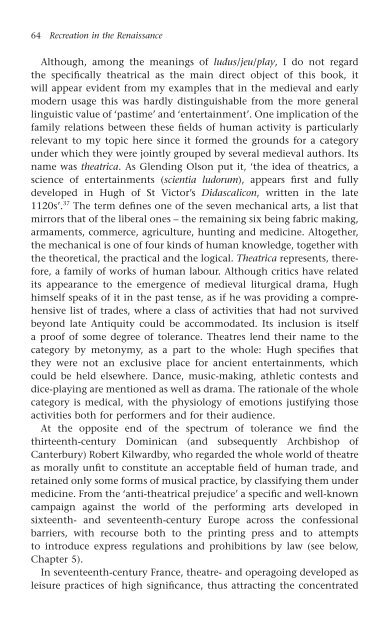Recreation in the Renaissance
Recreation in the Renaissance
Recreation in the Renaissance
- No tags were found...
Create successful ePaper yourself
Turn your PDF publications into a flip-book with our unique Google optimized e-Paper software.
64 <strong>Recreation</strong> <strong>in</strong> <strong>the</strong> <strong>Renaissance</strong><br />
Although, among <strong>the</strong> mean<strong>in</strong>gs of ludus/jeu/play, I do not regard<br />
<strong>the</strong> specifically <strong>the</strong>atrical as <strong>the</strong> ma<strong>in</strong> direct object of this book, it<br />
will appear evident from my examples that <strong>in</strong> <strong>the</strong> medieval and early<br />
modern usage this was hardly dist<strong>in</strong>guishable from <strong>the</strong> more general<br />
l<strong>in</strong>guistic value of ‘pastime’ and ‘enterta<strong>in</strong>ment’. One implication of <strong>the</strong><br />
family relations between <strong>the</strong>se fields of human activity is particularly<br />
relevant to my topic here s<strong>in</strong>ce it formed <strong>the</strong> grounds for a category<br />
under which <strong>the</strong>y were jo<strong>in</strong>tly grouped by several medieval authors. Its<br />
name was <strong>the</strong>atrica. As Glend<strong>in</strong>g Olson put it, ‘<strong>the</strong> idea of <strong>the</strong>atrics, a<br />
science of enterta<strong>in</strong>ments (scientia ludorum), appears first and fully<br />
developed <strong>in</strong> Hugh of St Victor’s Didascalicon, written <strong>in</strong> <strong>the</strong> late<br />
1120s’. 37 The term def<strong>in</strong>es one of <strong>the</strong> seven mechanical arts, a list that<br />
mirrors that of <strong>the</strong> liberal ones – <strong>the</strong> rema<strong>in</strong><strong>in</strong>g six be<strong>in</strong>g fabric mak<strong>in</strong>g,<br />
armaments, commerce, agriculture, hunt<strong>in</strong>g and medic<strong>in</strong>e. Altoge<strong>the</strong>r,<br />
<strong>the</strong> mechanical is one of four k<strong>in</strong>ds of human knowledge, toge<strong>the</strong>r with<br />
<strong>the</strong> <strong>the</strong>oretical, <strong>the</strong> practical and <strong>the</strong> logical. Theatrica represents, <strong>the</strong>refore,<br />
a family of works of human labour. Although critics have related<br />
its appearance to <strong>the</strong> emergence of medieval liturgical drama, Hugh<br />
himself speaks of it <strong>in</strong> <strong>the</strong> past tense, as if he was provid<strong>in</strong>g a comprehensive<br />
list of trades, where a class of activities that had not survived<br />
beyond late Antiquity could be accommodated. Its <strong>in</strong>clusion is itself<br />
a proof of some degree of tolerance. Theatres lend <strong>the</strong>ir name to <strong>the</strong><br />
category by metonymy, as a part to <strong>the</strong> whole: Hugh specifies that<br />
<strong>the</strong>y were not an exclusive place for ancient enterta<strong>in</strong>ments, which<br />
could be held elsewhere. Dance, music-mak<strong>in</strong>g, athletic contests and<br />
dice-play<strong>in</strong>g are mentioned as well as drama. The rationale of <strong>the</strong> whole<br />
category is medical, with <strong>the</strong> physiology of emotions justify<strong>in</strong>g those<br />
activities both for performers and for <strong>the</strong>ir audience.<br />
At <strong>the</strong> opposite end of <strong>the</strong> spectrum of tolerance we f<strong>in</strong>d <strong>the</strong><br />
thirteenth-century Dom<strong>in</strong>ican (and subsequently Archbishop of<br />
Canterbury) Robert Kilwardby, who regarded <strong>the</strong> whole world of <strong>the</strong>atre<br />
as morally unfit to constitute an acceptable field of human trade, and<br />
reta<strong>in</strong>ed only some forms of musical practice, by classify<strong>in</strong>g <strong>the</strong>m under<br />
medic<strong>in</strong>e. From <strong>the</strong> ‘anti-<strong>the</strong>atrical prejudice’ a specific and well-known<br />
campaign aga<strong>in</strong>st <strong>the</strong> world of <strong>the</strong> perform<strong>in</strong>g arts developed <strong>in</strong><br />
sixteenth- and seventeenth-century Europe across <strong>the</strong> confessional<br />
barriers, with recourse both to <strong>the</strong> pr<strong>in</strong>t<strong>in</strong>g press and to attempts<br />
to <strong>in</strong>troduce express regulations and prohibitions by law (see below,<br />
Chapter 5).<br />
In seventeenth-century France, <strong>the</strong>atre- and operago<strong>in</strong>g developed as<br />
leisure practices of high significance, thus attract<strong>in</strong>g <strong>the</strong> concentrated










